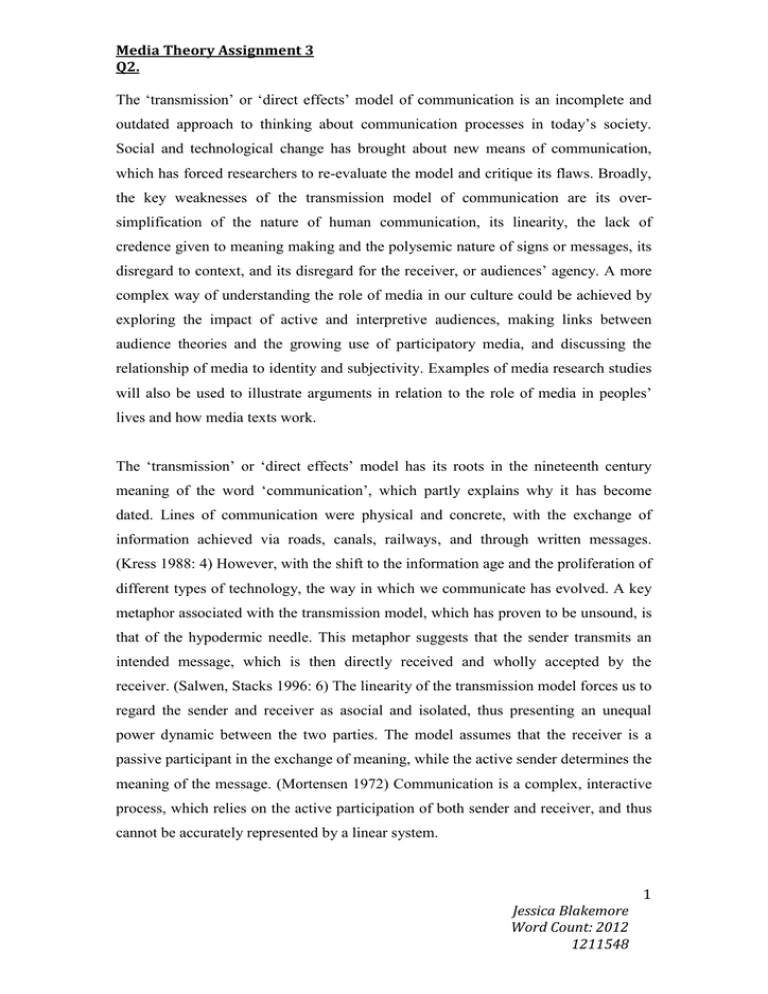Media Theory
advertisement

Media Theory Assignment 3 Q2. The ‘transmission’ or ‘direct effects’ model of communication is an incomplete and outdated approach to thinking about communication processes in today’s society. Social and technological change has brought about new means of communication, which has forced researchers to re-evaluate the model and critique its flaws. Broadly, the key weaknesses of the transmission model of communication are its oversimplification of the nature of human communication, its linearity, the lack of credence given to meaning making and the polysemic nature of signs or messages, its disregard to context, and its disregard for the receiver, or audiences’ agency. A more complex way of understanding the role of media in our culture could be achieved by exploring the impact of active and interpretive audiences, making links between audience theories and the growing use of participatory media, and discussing the relationship of media to identity and subjectivity. Examples of media research studies will also be used to illustrate arguments in relation to the role of media in peoples’ lives and how media texts work. The ‘transmission’ or ‘direct effects’ model has its roots in the nineteenth century meaning of the word ‘communication’, which partly explains why it has become dated. Lines of communication were physical and concrete, with the exchange of information achieved via roads, canals, railways, and through written messages. (Kress 1988: 4) However, with the shift to the information age and the proliferation of different types of technology, the way in which we communicate has evolved. A key metaphor associated with the transmission model, which has proven to be unsound, is that of the hypodermic needle. This metaphor suggests that the sender transmits an intended message, which is then directly received and wholly accepted by the receiver. (Salwen, Stacks 1996: 6) The linearity of the transmission model forces us to regard the sender and receiver as asocial and isolated, thus presenting an unequal power dynamic between the two parties. The model assumes that the receiver is a passive participant in the exchange of meaning, while the active sender determines the meaning of the message. (Mortensen 1972) Communication is a complex, interactive process, which relies on the active participation of both sender and receiver, and thus cannot be accurately represented by a linear system. Jessica Blakemore Word Count: 2012 1211548 1 Media Theory Assignment 3 Q2. Another key flaw of the transmission model is its assumption that all texts have a single meaning, and that that meaning is obvious to everyone. Semiotics tells us that due to the polysemic nature of signs, meaning is contingent on context and signs generate meaning from other texts. Thus, there is no single, fixed meaning in any message and as such the receiver’s interpretation is central to the meaning-making process. The same message could represent multiple meanings, which depend on the receiver’s situational, social, institutional, political, cultural, and historical context. (Chandler 1995) An example of this can be found in the research Collins and Wellman (1982) conducted on young children and their comprehension of television drama. Despite lacking the required “scripts and schemas”(Livingstone 1990: 52), the children still made sense of the narrative albeit in a different way. After the introduction of the missing script or cue, the children would interpret the text through their own frame of understanding, irrespective of the producer’s interpolation of the text. Thus it is clear that context plays an integral role in the process of communication, which is blatantly disregarded as an influence in the transmission model. According to Kress (10), “the structures, processes and contents of communication are given by culture.” A number of theorists assert that culture and communication are inseparable; they are intertwined in the creation and exchange of meaning. In other words, culture brings into existence meaningful objects and communication exchanges this meaning between social and cultural agents. (Kress) When taking into account the role of context in meaning making, it is clear that messages do not solely originate from the sender. Rather, meaning is drawn from an individual’s established culture and social groups, and therefore messages are never truly original or the sender’s own. Most importantly, the model ignores the possibility that the receiver is an active participant who, rather than passively absorbs meaning, is capable of reconstructing the message they are offered. The transmission model does not allow for any agency from the receiver, which is a great oversight. It also does not take into account the possibility of the receiver already being aware of the message, and the subsequent mutuality the sender and receiver could enjoy. This contrasts with Carey’s (33) idea of the model as a “process of transmitting messages at a distance for the purpose of Jessica Blakemore Word Count: 2012 1211548 2 Media Theory Assignment 3 Q2. control.” If this were the case in all instances of communication, the main purpose of a message would be to persuade or to engender attitude change in the receiver. This ignores the fact that there is often contestation and debate around the meaning of messages, and messages are constantly interpreted and re-interpreted by different individuals. Lastly, the model disregards the importance of the sender and receivers’ social positioning. This plays into structures of power, authority and solidarity, which have considerable influence over the way in which people interpret messages and make meaning. The sheer number of flaws in the transmission model of communication makes it clear that it is an overly simplistic way of framing our understanding of the role of media in our culture. A distinctive feature of the transmission model, which draws on theories of mass communication, is how all people are treated as an undifferentiated mass, which elucidates its failure to account for audience agency. McQuail (2000: 40) describes the mass audience as “large aggregates of dispersed and passive spectators, without opportunities to respond or to participate in a genuine way.” Despite similar claims that audiences’ have become “mindless consumers, stupefied and blinded by predigested cultural texts” (Hodkinson 2011: 119), the idea of active and interpretive audiences’ has become more prevalent as technology advances. Research into the genre of soap opera and its impact on the viewer succinctly illustrates the active and participatory involvement of the receiver. Hobson’s (1990) study of soap operas’ has found that viewers are critically engaged with the program, whilst actively building up a complex knowledge about the shows history and characters. Livingstone (45) expands on this idea by suggesting that the viewer’s knowledge of the show plays directly into their interpretation and re-interpretation of the text. The complexity of the text “invites the viewer to impose a certain order or closure according to his or her own notions of what is likely or desirable or meaningful” (Livingstone 53), which falsifies the idea that a text has a singular fixed meaning. Texts are often social, and this has become evident with the shift to audiences that are productive users. Texts are increasingly interactive and provide the receiver with opportunities to produce user-generated content on various platforms. A platform Jessica Blakemore Word Count: 2012 1211548 3 Media Theory Assignment 3 Q2. such as Facebook produces social networks, World of Warcraft produces interactive and community gameplay, whereas add-on apps for IPhones produce user-guides. Media consumers now have the opportunity to become media producers. Social networking sites are reliant on active participation, which includes making, uploading, writing, commenting, reviewing and organizing. Fans of television programs can now share their passion to a global community through different forms of expression such as fan websites, fiction, mash-ups or blogging. The sense of community that fan websites provide, and that the Internet facilitates, fosters an environment for cocollaboration. Fan fiction in particular is an example of the way in which audience’s actively re-interpret messages they receive. Fans of a pop-culture franchise use a show’s pre-established characters and story arcs to write supplemental stories to fill in plot holes, spin-off, or to create their own version of the episodes, chapters, or relationships etc. The television show Supernatural has a cult following on websites dedicated to fan fiction, with many stories depicting or assuming a romantic connection between the two brothers. The popularity of this coupling has resulted in a feedback loop to the directors and producers of the show, who have made both subtle and obvious mention to it in numerous episodes. Thus, the receiver can influence the sender through the growth of participatory media. Online computer games challenge the transmission model’s applicability to an even further extent. Audiences’, in this case players’, are far from the passive receivers’ depicted in the model. They are an integral part of the production process of the text, as games “draw on their audiences’ inputs, require participation, and give feedback and rewards.” (Humphreys 2005: 37) With the advent of the Web 2.0 online games have become increasingly sociable, as developers have created coded affordances like chat bars that allow players to further entrench themselves in social networking. In games such as EverQuest, the narrative alters from person to person, which is indicative of the central role of the receiver. The audience plays a central role in the creation of the text, with their choices making gameplay a unique experience for every individual. EverQuest has no conclusion, as the text is produced through the players’ consumption and is added to via their feedback. Most games of this nature bind players in a “contractual relationship to an End User License Agreement in Jessica Blakemore Word Count: 2012 1211548 4 Media Theory Assignment 3 Q2. which they give up ownership rights and Intellectual Property rights to in-game content.” (Humphreys 41) This means that even though the text is produced through the players’ consumption, everything included in the game belongs solely to Sony. This new media form generates a new relationship between the developer and player, which were previously seen as independent of one another. The role of players’ in the involvement of games introduces a more “nuanced power dynamic” (Humphreys 42), as each party is dependent on the other. The growing participation of audiences’ as productive users has a significant impact on the way in which we relate to each other, they way in which we construct our public identity, our sense of privacy and public space, and the way in which we understand ourselves. Foucault’s theory of panoptical surveillance can be applied to today’s society and the construction of our sense of self. The panopticon is a type of building designed to allow an observer to watch all inmates of an institution without them being able to tell whether or not they are being surveyed. (Foucault 1975) Although not constrained by a literal building or construction, today’s society is subjected to this disciplinary form of power. Everyone is constantly under surveillance by media, and the development of computer processing and storage power has made this information easier to be taken advantage of. (Andrejevic 2002: 231) This constant surveillance helps to construct and enforce social norms that become naturalized and thus part of one’s sense of self. As a result, people are ranked and differentiated by this pervasive, normalizing judgment. Those who don’t comply with the norm are brought up to community standards, sometimes without even realizing. The influence of the media itself as a tool is completely disregarded in the transmission model of communication, and needs to be taken into account. The relationship between identity and subjectivity is at least partially formed through engagement with media. The ‘transmission’ or ‘direct effects’ model is an overly simplistic and outdated way of thinking about communication in today’s media driven society. A number of academics have critiqued this model of communication over time and have laid bare a number of its inherent flaws. One of its main deficiencies is that it does not take Jessica Blakemore Word Count: 2012 1211548 5 Media Theory Assignment 3 Q2. context into account, or the way in which contextual factors effect audience interpretations. The model is also unidirectional, assumes that the sender and receiver are asocial and isolated, and allows no agency from the receiver. Technological advances have prompted the rise of participatory media such as social networks, online games, and fan fiction. Interactivity within these spaces is indicative of active and productive audiences who are not passive conduits for information, as the transmission model would suggest. The proliferation of media has sparked social change, with concepts of identity and subjectivity the most affected. With the rise of productive audiences and participatory media, the transmission model is fast becoming obsolete. Jessica Blakemore Word Count: 2012 1211548 6 Media Theory Assignment 3 Q2. Reference List Mark Andrejevic (2002) ‘The work of being watched: Interactive media and the exploitation of self-disclosure” in Critical Studies in Media Communication, 19, (2), p. 231 Carey, J.W. (1988) Communication as culture: Essays on media and society. New York, Unwin Hyman Inc., p. 33 Daniel Chandler (1994) The Transmission Model of Communication, http://www.aber.ac.uk/media/Documents/short/trans.html, accessed 3/11/2011 Michel Foucault (1975) Discipline and Punish. The Birth of the Prison, London, Penguin (trans. Alan Sheridan 1977), pp. 170-204 Dorothy Hobson (1990) ‘Women audiences and the workplace’ in Mary-Ellen Brown (ed) Television and Women’s Culture, London, Sage, pp.61-71 Hodkinson, Paul (2011) ‘Chapter 6. Media as manipulation? Marxism and Ideology’ in Media Culture and Society. An Introduction, Sage, LA, London. p. 119 Humphreys, S. (2005) Productive Players: online computer games’ challenge to conventional media forms. Journal of Communication and Critical/Cultural Studies, 2, (1), pp. 37-42 Gunther Kress (1988) ‘Communication and Culture’ in G. Kress (ed) Communication and Culture: An Introduction, Sydney, New South Wales University Press, pp.4-19 Sonia Livingstone (1990) ‘The Active Viewer’ in S. Livingstone making Sense of Television, Oxford, Pergamon Press, p. 45, 53 Jessica Blakemore Word Count: 2012 1211548 7 Media Theory Assignment 3 Q2. Dennis McQuail (2000), ‘Concepts and Models’ in McQuail’s Mass Communication Theory (4th ed.), London, Sage, p. 40 David Mortensen (1972) ‘Communication: The Study of Human Communication’ in Chapter 2. Communication Models, New York, McGraw-Hill Book Co Michael Salwen, Stacks D (1996) An Integrated approach to communication theory and research, Routledge, p. 6 Jessica Blakemore Word Count: 2012 1211548 8






